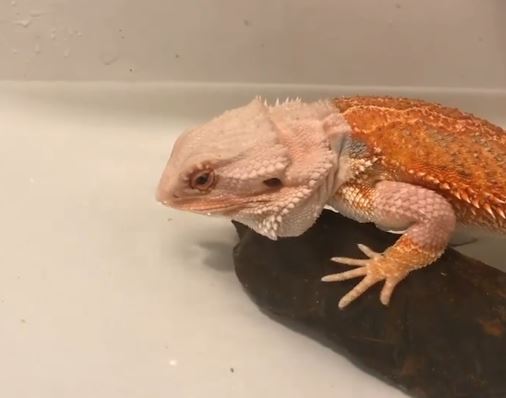Recently, there has been a common question among bearded dragon owners: “Is my bearded dragon dehydrated?”
Although bearded dragons have originated in desert places of Australia, that does not mean they do not need water.
By contrast, like other living creatures, lacking liquids might kill them faster than starvation.
Consequently, you should worry if your beardie shows some features of lacking liquids, as below.
To help you avoid or treat their disease successfully, I would like to show you some causes and solutions.
Scroll down for the full answer to the question, “Is my bearded dragon dehydrated?”
Related Posts:
- How High Can Beardies Jump and How to Keep Them Safe?
- Why Does My Beardie Run Away From Me?
- How Much UVB Does a Bearded Dragon Need? A Suitable UVB Level
- Can a Bearded Dragon Survive Outside? Detailed Guidelines and Useful Tips
- Bearded Dragon Teeth Care? What Do You Know About It?
Is My Bearded Dragon Dehydrated?
When a bearded dragon lacks liquids, his skin always has wrinkles and is loose from his body. Plus, you might notice his eyes become sunken.
For some, they lose their appetite and get lethargic. Poop often changes, or it might appear less than usual.
And do not forget to look at his saliva. The thickness of the liquid in your pet’s mouth also is a symptom of lacking liquids.
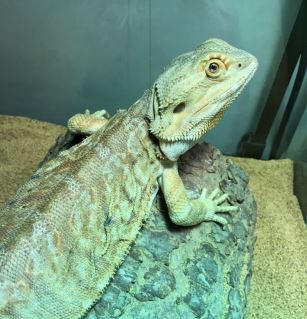
Why Do Bearded Dragons Lack Water?
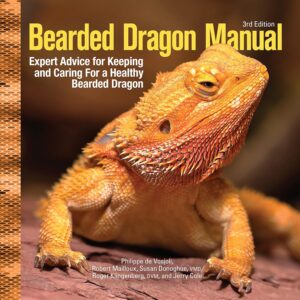 While many owners think that the lack of water is the only reason for lacking liquids, much research shows the opposite.
While many owners think that the lack of water is the only reason for lacking liquids, much research shows the opposite.
In actuality, overloading your pet with liquids or food containing water might also make him sick. The culprit is diarrhea. Because of too much waste in liquid form running out of his body, he loses water fast.
The second reason results from the beardie’s behavior. After some tests, I realize that a few bearded dragons can not find out the liquids in the bowl.
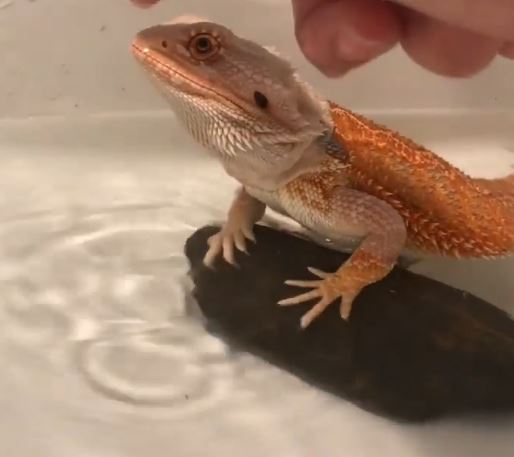
Although they have up to three eyes, they can only notice moving water, such as dew drops.
Of course, many intelligent pets can still understand what they got in the food bowl and drank it. However, some could not.
For this reason, if you have just brought a new beardie to your home, teaching him to get liquids in the bowl would help.
7 Symptoms You Should Know About Bearded Dragon Dehydration
Understanding the signals of lacking water in your pet’s body is crucial to have suitable treatment.
Therefore, take a hard look at the key symptoms below!
1. Wrinkled Skin
The first signal you can see when a bearded dragon gets dehydrated is the wrinkled skin. That means abnormal wrinkles are appearing on his skin.
When that kind of dragon becomes dehydrated, his skin also loses the ability to return or stretch to its regular shape and size. For this reason, his skin stays fall loosely from his body.
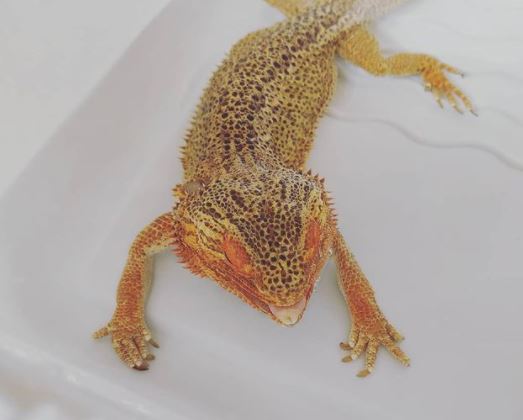
However, lacking liquids might not be the only cause of loose skin. Some young beardies also appear wrinkles on their body. For the reason that their inside parts have not entirely developed.
To make sure which is the real cause, try the pinch test.
First, place your pet straight. If not, you might come to the wrong conclusion.
Some specific parts of bearded dragons feature naturally wrinkled skin.
Once you have not identified the particular area yet, only looked at them and insisted that your pet get the disease, you might make a huge mistake.
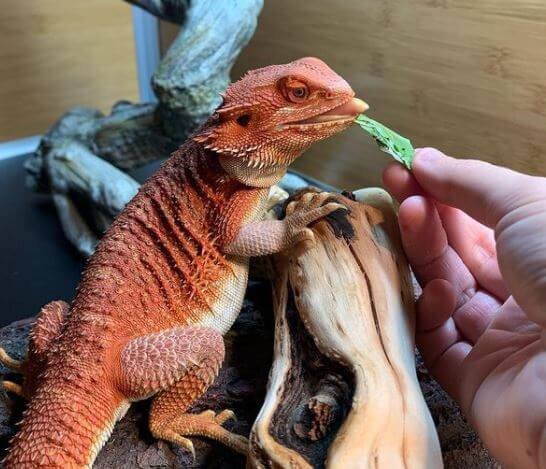
Also, put your pet on a scale and detach his weight before doing the test. With underweight beardies, loose skin is relatively routine.
Once you have already diminished the unrelated reasons, pinch your pet’s skin.
Try to do that on as many areas of his body as possible. Then, you can know whether they can return to their original position quickly or not.
A regular skin would bounce back immediately. By contrast, a dehydrated one takes a longer time to do.
2. Saliva Tackiness
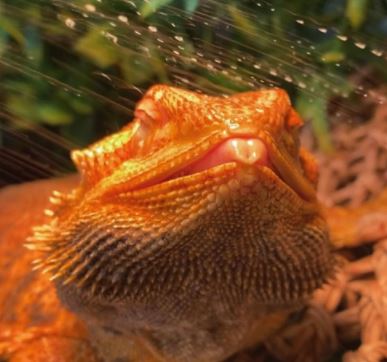
Out of bearded dragon signs of dehydration, the thickness of saliva is relatively straightforward.
Find a period when your beardie is quite friendly and opens his mouth. Carefully look at the inside to detach the consistency of the saliva.
If the sticky liquid is thicker than usual, the owners should know their pet’s body is lacking fluids.
3. Decrease of Appetite
Like any creature, your bearded dragon needs food to survive.
Nevertheless, suppose he loses his appetite in a long time. It would be best if you took him to the veterinarian as soon as possible.
The loss often leads to a quick death.
4. Lethargy
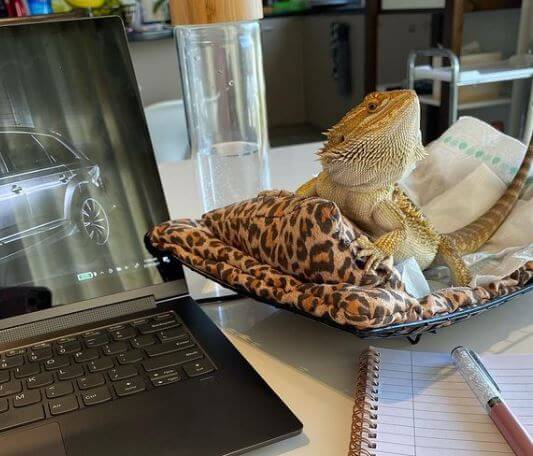
Besides the decreasing desire for food, bearded dragons also become lethargic once they lose water.
 For more details in the natural world, you might rarely see the animal’s sickness, listlessness, or immobility. Once they show the signal, they could become the prey of many other predators.
For more details in the natural world, you might rarely see the animal’s sickness, listlessness, or immobility. Once they show the signal, they could become the prey of many other predators.
But, according to scientific studies, in captivity, the number of beardies having lethargy is more significant than expected, mainly resulting from the blackness of skilled care.
The loss of energy might have its feet from many diseases. Combing with other symptoms, I explain this part, and it leads to lacking liquids.
5. Poop Changes
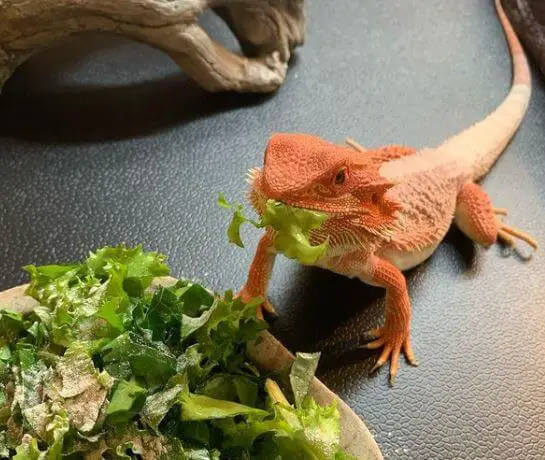
When you clean up your pet’s cage, check his poop to identify if your bearded dragon is dehydrated.
Typically, the beardie’s poop includes three elements: urine, fecal, and uric acid salt.
In urine, excess water accounts for the rest of the urine waste for the most part.
Consequently, once the pet losses liquids, his poop might become drier, and there is no urine involved.
Moreover, the percentage of the uric acid’s salt would sharply decrease, and the fecal is likely to be more solid.
That is a normal self-protection mode of an animal’s body when he lacks liquids. He could try to keep as many fluids inside as possible.
6. Lack of Poop
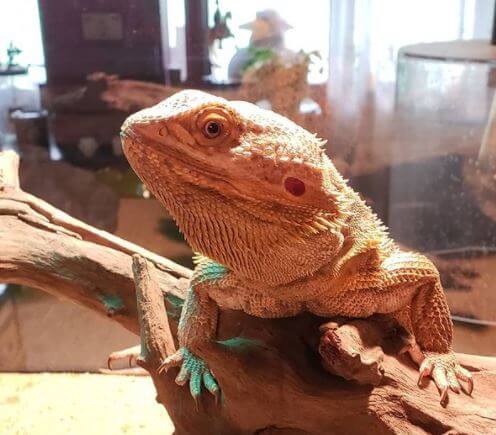
As you know, lacking water has a considerably negative impact on the digestion process. That means that your pet having fewer poops than usual is one of the bearded dragon dehydration signs.
In other words, that is a symptom of constipation.
Moreover, the fecal becomes drier. The bearded dragon finds it more challenging and uncomfortable while getting rid of solid waste. The poop might appear as blood as well.
Constipation and impaction are relatively familiar, so keep in mind to distinguish them.
7. Sunken Eyes
A few diseases are having the symptoms of sunken eyes in beardies. One of them is lacking water.
That is when the vessels around the eyes are prominent. Plus, the skin around seems to be hollow, sunken, and dark. It tends to be closer to the eye socket’s bone.
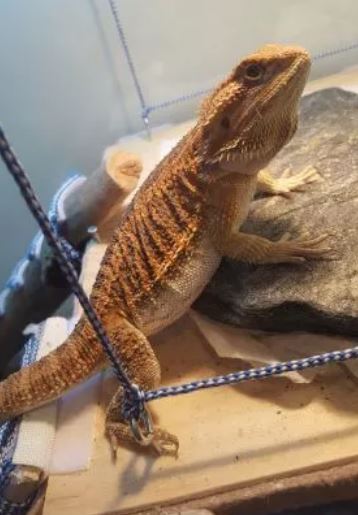
What Is Bearded Dragon Dehydration Cure?
Instead of immediately taking your pet to the veterinarian, solve his problems with some methods below. Who knows, they might both save you time and money alike.
1. Spraying
Of course, the first solution to help your pet rehydrate is to spray water. You can try to mist it on surfaces your pet can lick, such as the cage’s floor.
Keep in mind to clean the surface before misting. If not, drinking dirty liquids might lead to a more severe illness than lacking liquids.
To do that, you should set the spraying time at the end of the day after cleaning the enclosure. Do not spray on the loose substrate. Try items like tiles or slate tiles would be best.
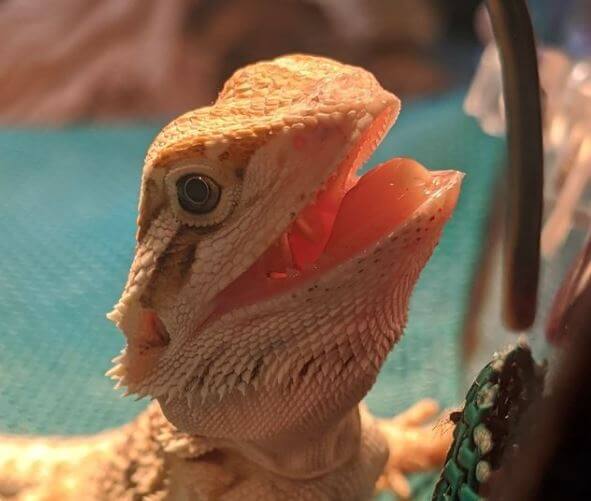
Significantly, the solution would be advantageous if your dragon is having trouble with shedding. Plus, it can substantially improve the humidity level.
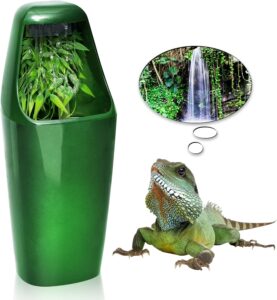 The central core of the method is to give your pet a chance to study drinking and relaxing.
The central core of the method is to give your pet a chance to study drinking and relaxing.
With new beardies, they might be unfamiliar with strange bowls. Therefore, giving them a misted surface to slide through and lick on is much more helpful.
Additionally, as I have just mentioned, that kind of dragon cannot notice still but moving liquid drops.
2. Using a Water Bowl
Whether bearded dragons know to drink liquids in the bowl or not, you always need to put one on his cage.
Besides, please keep it clean, comprehensive, and shallow enough. From time to time, beardies might like to stay or lay in it, making it valuable equipment for dehydrated bearded dragon treatment.
Bear in mind to change the bowl often and set it in a cool place. Otherwise, your pet might have to suffer more severe diseases.
For instance, if you put the same bowl from day to day, that is an excellent chance to develop bacteria, parasites, and pathogens. Plus, it can prevent the dragon’s house from having a too high level of humidity.
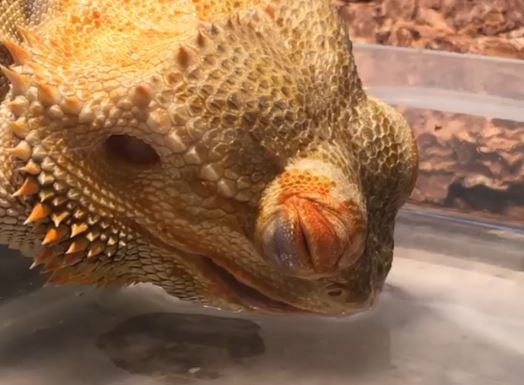
Remarkably, once you use a glass tank, the percentage of water in the air is often higher than average. That might be the root of excessive humidity troubles.
Instead of putting the water bowl in, consider choosing items that add ventilation. My recommendation is wood, socks of rice, or others.
More importantly, many experienced owners share tips and tricks to let their pets understand how to drink in a water bowl. Like training other animals, you have to tell them what to do based on their ability.
In this case, make the water in the bowl move.
To do that, I often spray the water on the tree in my pet’s tank. Then, the bowl is put under the tree so that it can get the drops dripping. Not only is that useful, but it also makes my pet interested when he is bored.
What’s more, suppose your pet is deadly thirsty. Quickly spray the water on your clean hand. While it requires more effort, it would save your pet’s life immediately.
If you still are not sure how to teach young beardies to drink, take a look at this video to know more:
3. Bathing
There is no more popular, convenient, or efficient treatment to solve lacking liquids than bathing.
However, while some bearded dragons enjoy the time, some might find it annoying and frustrating. As a result, remember to check your pet’s preference.
Plus, the maximum bathing time should range from 20 to 30 minutes. Keep the water temperature varying from 32°C to 36°C.
Once it is your first time to bathe the dragon, think about buying a thermometer for sure. There are some excellent products you can choose recently, such as:
Frequently Asked Questions About Bearded Dragon Dehydration
1. Does a Bearded Dragon Absorb Water Through His Skin?
My answer is no. Bearded dragons cannot absorb water via the skin. Just consider they could, you might not have seen such a massive number of those dragons die every year.
However, as desert reptiles, they do have special techniques to keep water in their body. For instance, they can take water via the vent path. Plus, they can store water droplets by themselves.
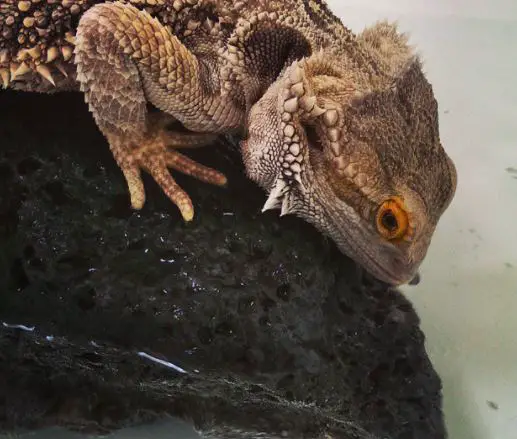
2. Can Bearded Dragons Eat Dehydrated Fruit?
Because the bearded dragon is an omnivore, it can eat most types of food, including dried fruit.
Nevertheless, keep in mind that the fruit has to be safe with them. Plus, that food does provide less water than fresh fruit. It also involves a high level of sugar.
3. What Can I Give My Dehydrated Bearded Dragon?
Greens like fruit and vegetables are my suggestions.
Based on the cause of the disease, you can consider increasing the suitable amount of greens in his diet.
According to much research, those kinds of food involve a considerable number of calcium and vitamins.
4. How Much Water to Give a Dehydrated Bearded Dragon?
Depending on your bearded dragons’ condition, you can give them a suitable amount of water. For instance, some beardies are thirsty for one or two days. They might need 60 to 100ml per kilo.
That means around five to six teaspoons of water might be enough. The more seriously dehydrated they get, the more water they need.
5. How Often Should You Spray Your Beardies With Water?
Toughly two times per week is my recommendation.
Notably, once your pet does not know how to drink in his bowl, you can use a spray bottle to spritz on his body. That would also prevent the dragon from being dehydrated.
Conclusion
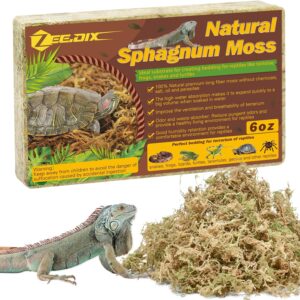 To conclude, above are the complete information related to the question, “Is my bearded dragon dehydrated?”
To conclude, above are the complete information related to the question, “Is my bearded dragon dehydrated?”
In a nutshell, a dehydrated bearded dragon often has wrinkled skin, sunken eyes, poop changes, loss of appetite, and others.
To tackle the problems, you can spray water on his body and use the water bowl alike. Plus, bathing would be helpful.
Hopefully, the article has helped you identify your pet’s disease successfully and quickly.
Key points for identifying if your bearded dragon is dehydrated:
Dehydration in bearded dragons can be a serious health concern, so it’s crucial to be aware of the signs and symptoms. Here’s how to recognize if your bearded dragon might be dehydrated:
1. Skin Appearance:
- Check the skin for signs of dehydration. A well-hydrated bearded dragon should have smooth, elastic skin. Dehydrated dragons may have wrinkled or saggy skin.
2. Sunken Eyes:
- Sunken or deeply recessed eyes are a common sign of dehydration. Healthy bearded dragons have plump, rounded eyes.
3. Reduced Energy:
- Dehydrated bearded dragons often become lethargic or less active. If your dragon is unusually sluggish, it could be a sign of dehydration.
4. Dark Urine or Lack of Urination:
- Dark, concentrated urine or a lack of urination may indicate dehydration. In well-hydrated dragons, urine is typically light in color.
5. Dry Mouth and Pale Gums:
- Open your dragon’s mouth and inspect the oral cavity. Dehydrated dragons may have a dry mouth and pale, tacky gums.
6. Reduced Appetite:
- A decrease in appetite can be a sign of dehydration. Offer water and monitor their food consumption.
7. Reduced or Absent Skin Pinching Response:
- When you gently pinch your bearded dragon’s skin, it should quickly snap back into place. Dehydrated skin may “tent” and remain raised.
8. Hard or Compact Stool:
- Dehydration can lead to hard, dry, and compacted stool. Normal stools should be moist and well-formed.
9. Lack of Fluid Intake:
- If you notice that your dragon is not drinking or avoiding the water dish, it may be an indication of dehydration.
10. Sunken Fat Pads: – The fat pads on the sides of a bearded dragon’s head may appear sunken in dehydrated individuals.
11. Lack of Elbow Lubrication: – A well-hydrated bearded dragon’s elbow joint should appear well-lubricated and smooth. Dehydrated dragons may show dry, rough patches on the elbow.
12. Rapid Weight Loss: – Dehydration can lead to rapid weight loss in bearded dragons. Monitor their weight and consult a veterinarian if you notice a significant drop.
13. Excessive Shedding Difficulty: – Dehydrated dragons may struggle to shed their skin. This can lead to retained shed or improper shedding.
14. Altered Behavior: – Dehydration can affect a bearded dragon’s behavior. They may become more irritable, aggressive, or display unusual actions.
15. Lack of Interest in Swimming: – Bearded dragons enjoy soaking and swimming, but dehydrated individuals may lose interest in these activities.
16. Hot Environment Concerns: – In extremely hot environments, dehydrated dragons may seek cooler areas to avoid excessive fluid loss through evaporation.
17. Seek Veterinary Care: – If you suspect your bearded dragon is dehydrated, it’s crucial to consult with a reptile veterinarian for a thorough evaluation and guidance on treatment.
In summary, recognizing the signs of dehydration in your bearded dragon is essential for their well-being. Regularly monitor their skin, eyes, behavior, and fluid intake to ensure they remain adequately hydrated. Promptly addressing dehydration can prevent more severe health issues and ensure your pet’s overall health and happiness.
Further Reading:
- Carolina Custom Cages Terrarium Review
- 8 Best Basking Rock for Beardie: What Is the Best Choice?
- 10 Best Thermometers for Beardie: How to Choose the Best One?
- 5 Best Beardie Lighting Setups for Beardie Lovers
- 9 Best Heat Lamps for Beardie: Natural Habitat Provided

